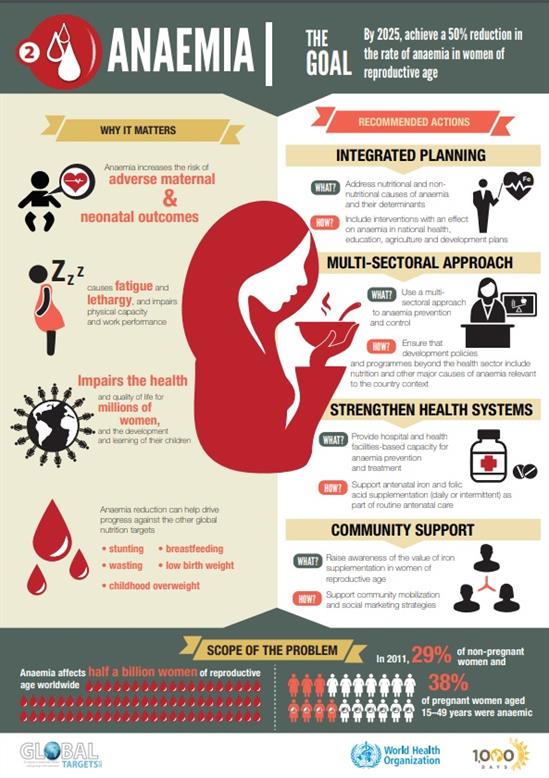Anaemia
Anaemia is a condition in which the number of red blood cells or the haemoglobin concentration within them is lower than normal. Haemoglobin is needed to carry oxygen and if you have too few or abnormal red blood cells, or not enough haemoglobin, there will be a decreased capacity of the blood to carry oxygen to the body’s tissues. This results in symptoms such as fatigue, weakness, dizziness and shortness of breath, among others. The optimal haemoglobin concentration needed to meet physiologic needs varies by age, sex, elevation of residence, smoking habits and pregnancy status. The most common causes of anaemia include nutritional deficiencies, particularly iron deficiency, though deficiencies in folate, vitamins B12 and A are also important causes; haemoglobinopathies; and infectious diseases, such as malaria, tuberculosis, HIV and parasitic infections.
Anaemia is a serious global public health problem that particularly affects young children and pregnant women. WHO estimates that 42% of children less than 5 years of age and 40% of pregnant women worldwide are anaemic.
Anaemia can cause a range of symptoms including fatigue, weakness, dizziness and drowsiness. Children and pregnant women are especially vulnerable, with an increased risk of maternal and child mortality. The prevalence of anaemia remains high globally, particularly in low-income settings, where a significant proportion of young children and women of childbearing age can be assumed to be anaemic. Iron deficiency anaemia has also been shown to affect cognitive and physical development in children and reduce productivity in adults.
Anaemia is an indicator of both poor nutrition and poor health. It is problematic on its own, but it can also impact other global nutritional concerns such as stunting and wasting, low birth weight and childhood overweight and obesity due to lack of energy to exercise. School performance in children and reduced work productivity in adults due to anaemia can have further social and economic impacts for the individual and family.
While iron deficiency anaemia is the most common form and is relatively easy to treat through dietary changes, other forms of anaemia require health interventions that may be less accessible. Accurate characterisation of anaemia is critical to understand the burden and epidemiology of this problem, for planning public health interventions, and for clinical care of people across the life course.
WHO oversees several programmes across all WHO Regions to help reduce the prevalence of anaemia through treatment and prevention. These guidelines, policies and interventions aim to increase dietary diversity, improve infant feeding practices and improve the bioavailability and intake of micronutrients through fortification or supplementation with iron, folic acid and other vitamins and mineral. Social and behaviour change communication strategies are used to change nutrition-related behaviours. Interventions to address the underlying and basic causes of anaemia look at issues such as disease control, water, sanitation and hygiene, reproductive health and root causes such as poverty, lack of education and gender norms.
In 2016, WHO started a five-year project to review its global guidelines for haemoglobin cut-offs used to define anaemia with the aim to provide evidence-informed recommendations on assessing anaemia in individuals and populations.
See here for more information.











